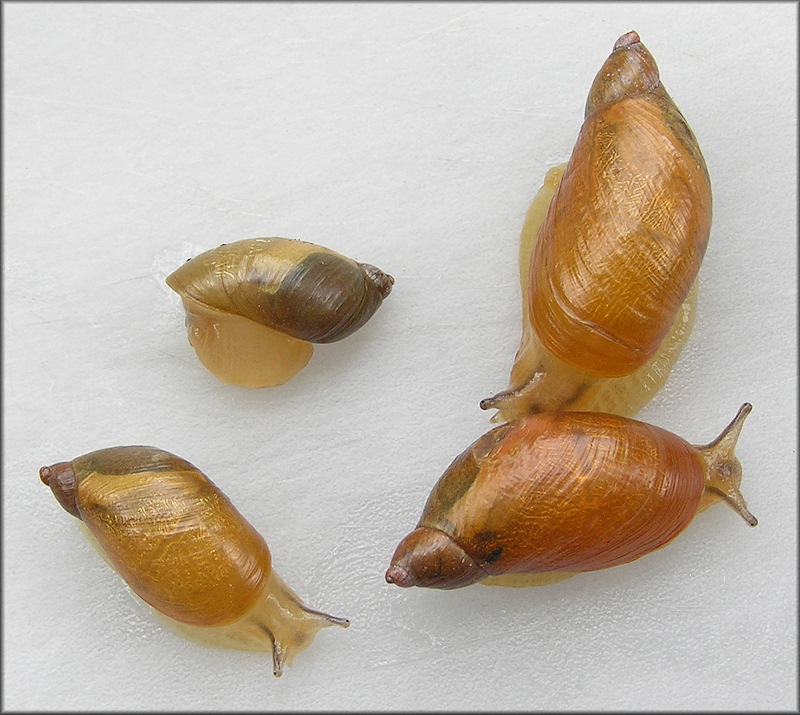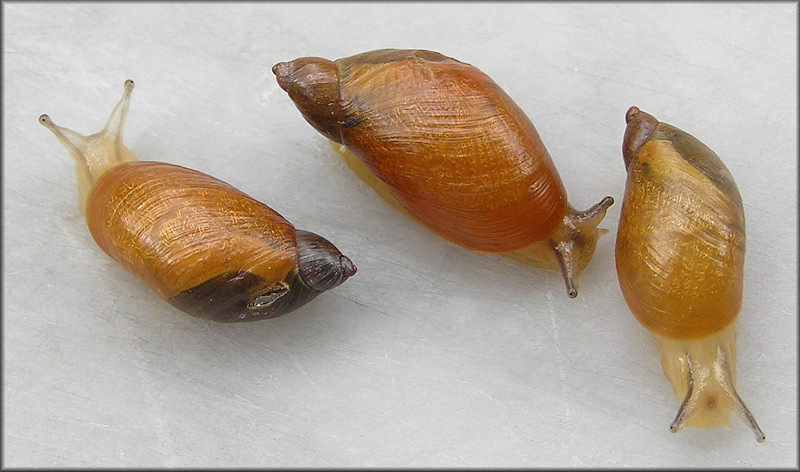|
Oxyloma retusum (I. Lea, 1834) Blunt Ambersnail |
|
|
|
|
|
In flower garden and crawling on weeds and grasses elsewhere on the grounds, residential property, Vinalhaven, Knox Co., Maine, H. Lee! 15 August, 2011. Up to 20 mm. A second population of this large ambersnail was found in a flower garden in W. Stonington, Hancock Co., some 15 miles distant. |
|
The shells in these series tend to become vividly golden as they
approach maximal growth, yet adolescent specimens are
indistinguishable from the largest typical Oxyloma retusum
collected elsewhere in the species range. e.g., Vermont
Nonetheless, there are some quite atypical aspects to the story: (1) The largest shells in each sample are 20 mm in height. This size has been reported only in a few populations of O. retusum in the upper Mississippi River Valley, which snails were named O. r. magister (Pilsbry, 1899). The color is not mentioned, so one may assume it to be pale yellowish. (2) Pilsbry (1948 785-788) mentions "golden" in detailing only one population of this species - from along the Calumet River, near Chicago. These shells were named O. calumetensis (Calkins, 1878), and those of the type series measured 12 to 13 mm in height. (3) This species (and genus) has not been reported from Maine previously. In fact, the quite easily distinguished Novisuccinea ovalis (Say, 1817) has heretofore been the only ambersnail (family Succineidae) known from the state (Hubricht, 1985). (4) Finally, what about the artificial environment of these two colonies and the large and abrupt zoogeographic leap? To a terrestrial malacologist the snails' synanthropic habit and disturbed habitat is a red flag for adventitious origin. Could these snails have been introduced on horticultural or nursery stock? This contingency is not at all that unlikely. Under such a scenario the ambersnail stock might have originated as far away as South America, Eurasia, or Africa! Pilsbry (loc. cit.) synonymized Oxyloma r. magister (Pilsbry, 1899) and O. calumetensis (Calkins, 1878) with O. retusum, and this analysis has been accepted by subsequent workers, e.g., Hubricht (1985), Turgeon, Quinn, et al. (1999). Given this amplitude of variation in shell features, acceptance of O. retusum as the proper placement for these golden giants seems reasonable - at least for the time being. On the other hand, for well over a half-century, every ambersnail taxonomist has faulted sole reliance on shell characters in species (and, in some instances, generic) identifications. Traditionally, genital anatomy, and, more recently, molecular genetics must be applied to arrive at proper systematic placement in this particularly perplexing group. Accordingly, material from these two populations has been sent to Dr. Gary Barker of the University of Waikato, New Zealand, whose lab is performing an integrated study of the systematics of ambersnails worldwide. Hopefully an epilogue to this report may appear soon.Hubricht, L., 1985. The distributions of the native land mollusks of the Eastern United States. Fieldiana 24(1359): pp. 1-191 + viii. June 28. Pilsbry, H.A., 1948. Land Mollusca of North America north of Mexico vol II part 2. Academy of Natural Sciences, Philadelphia. xlvi + 591-1113. Turgeon, D.D., J.F. Quinn, Jr., A.E. Bogan, E.V. Coan, F.G. Hochberg, W.G. Lyons, P.M. Mikkelsen, R.J. Neves, C.F.E. Roper, G. Rosenberg, B. Roth, A. Scheltema, F.G. Thompson, M. Vecchione, and J.D. Williams, 1998. Common and scientific names of aquatic invertebrates from the United States and Canada: mollusks, 2nd edition. American Fisheries Society, Special Publication 26, Bethesda, Maryland. ix + pp. 1-509 + 16 pls. (unpaginated). |

